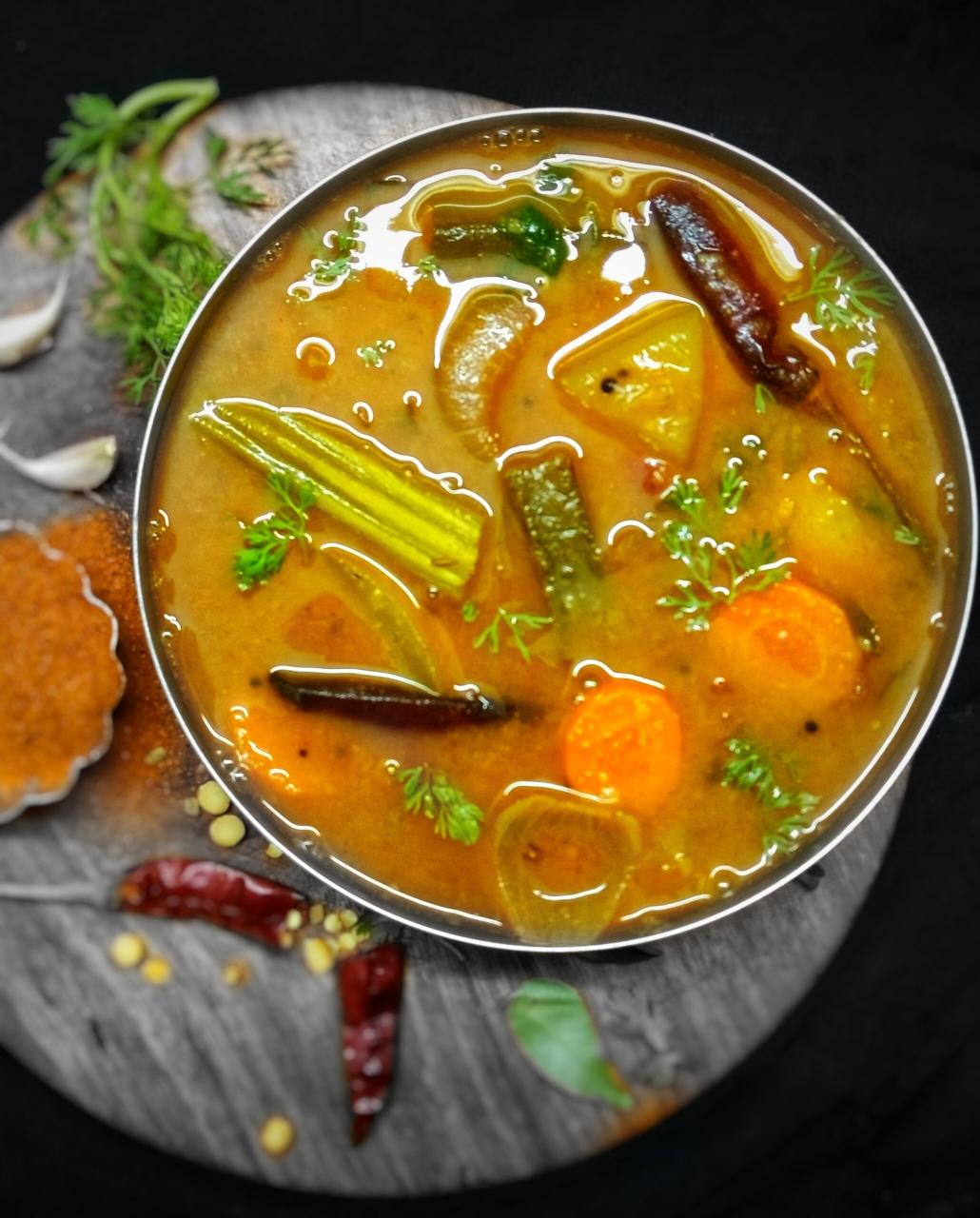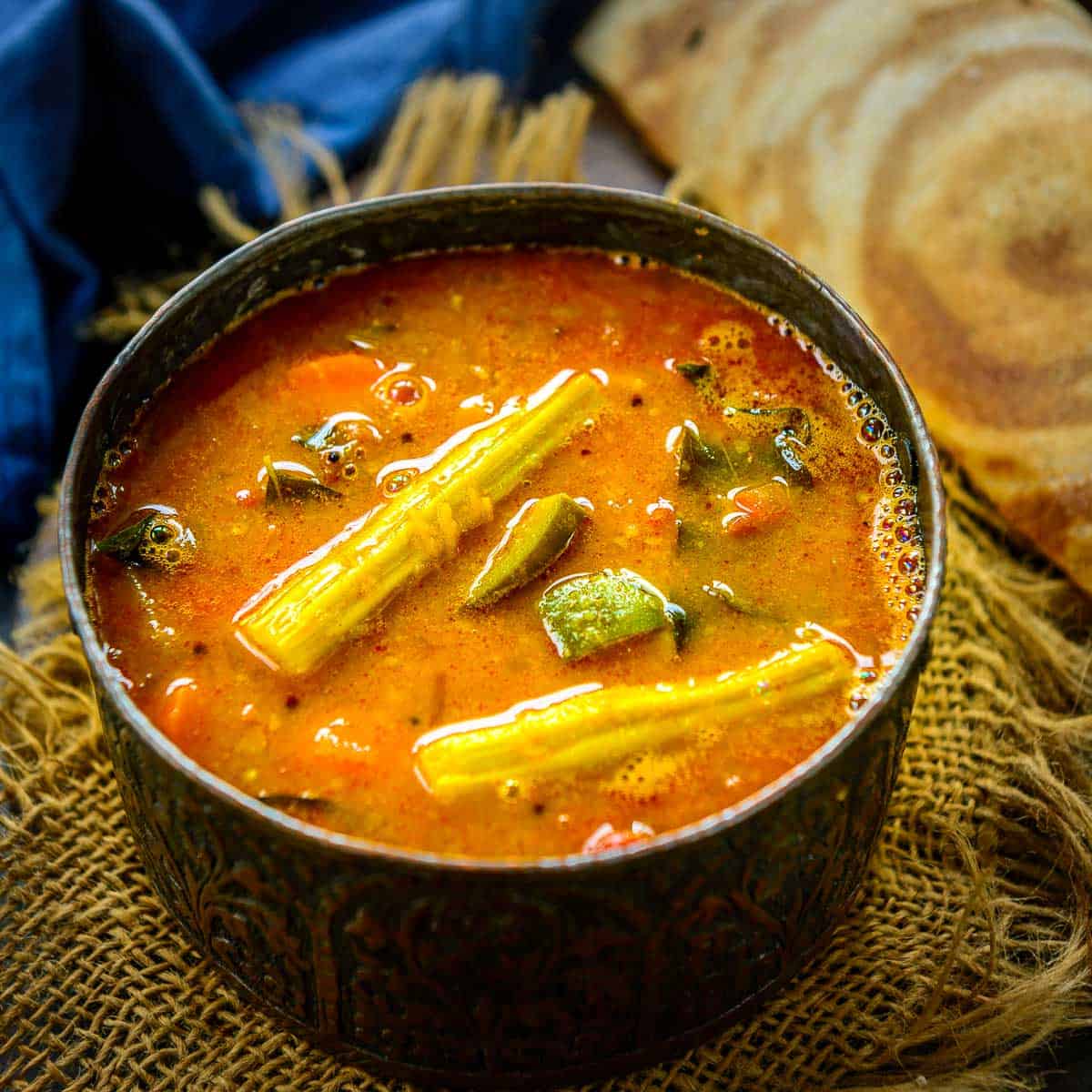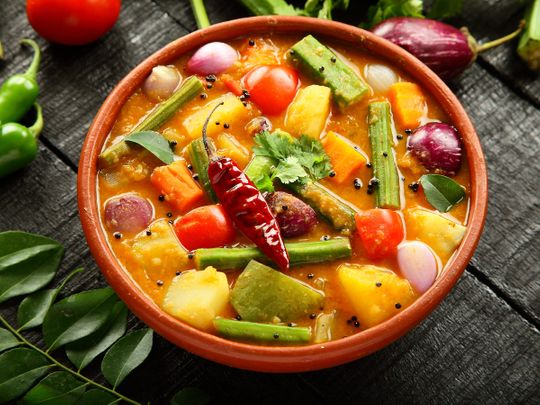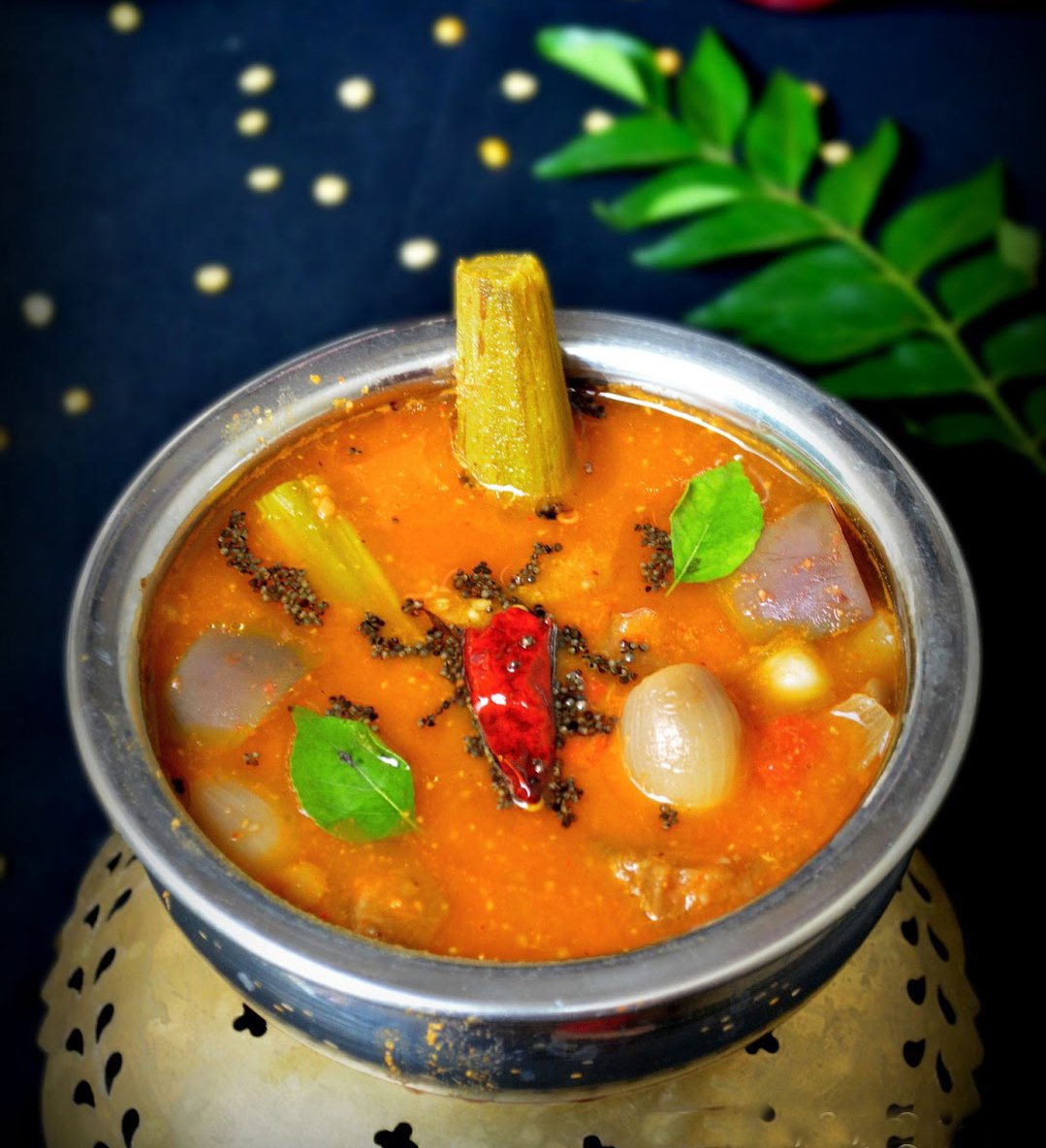Mixed Vegetable Sambar is a flavorful and nutritious South Indian stew known for its aromatic blend of lentils, mixed vegetables, and a unique blend of spices called sambar masala. This traditional dish is a staple in South Indian households and is revered for its comforting warmth and versatile nature, as it pairs well with numerous other dishes.
The foundation of sambar is typically a type of lentil—often pigeon peas (toor dal)—which is boiled until soft and then mashed to create a thick and hearty base. To this, a variety of vegetables such as okra, carrots, drumsticks, eggplant, pumpkin, and tomatoes are added, each contributing their own textures and flavors to the stew.
Sambar gains its distinctive taste from the sambar masala, a spice mixture that usually includes roasted lentils, dried red chilies, coriander seeds, fenugreek seeds, mustard seeds, and curry leaves, among other ingredients. These spices are ground together to form a powder or paste that infuses the sambar with depth and complex flavors.
Mixed Vegetable Sambar Recipe


Mixed Vegetable Sambar
Equipment
- 1 electric pressure cooker
Ingredients
- 1/2 cup split pigeon peas rinsed twice in cool water, drained
- 41/2 cups water divided
- 1 cherry tomato–size seedless tamarind block soaked in 11/2 cups boiling water for 30 minutes
- 1/2 teaspoon corn oil
- 5 dried Guntur chiles
- 3 tablespoons coriander seeds
- 11/2 tablespoons Bengal gram
- 1 onion roughly chopped, plus 1 extra tablespoon chopped onion (optional)
- 2 teaspoons husked whole black lentils
- 1 teaspoon raw sona masoori or ponni rice optional
- 2 teaspoons fenugreek seeds divided
- 1/4 teaspoon cumin seeds
- 1/4 cup shredded fresh coconut or frozen, thawed to room temperature
- 1 tablespoon coconut oil
- 1 teaspoon mustard seeds
- 2 curry leaf sprigs
- 1/4 teaspoon asafoetida
- 1 cup chunked mixed vegetables such as brinjal, radish, and okra
- 1 tablespoon salt
- 1 teaspoon powdered jaggery
- 1/2 teaspoon ground turmeric
Instructions
- In an electric pressure cooker, such as the Instant Pot®, or in a stovetop pressure cooker or pressure pan, combine the pigeon peas and 2 cups of water.
- For an electric pressure cooker, lock the lid into place and make sure the valve is in the Sealed position. Select Pressure Cook or Manual and set the time to 20 minutes on High Pressure. Let the pressure release naturally. For a stovetop pressure cooker, place it over medium heat and place the lid on. Ensure the sealing ring is on and place the weight on. Pressure cook until the cooker “whistles” 3 to 4 times. Let the pressure release naturally.
- Carefully unlock and remove the lid and let the pigeon peas ncool. Mash the pigeon peas and set aside.
- Stir the tamarind and the water it has been soaking in. Using your fingers, remove the tamarind flesh and squeeze the juice from the pods, removing any fibers and membranes as well. Pour the mixture into a fine-mesh strainer set over a bowl and use a spoon to press as much of the pulp as possible through the strainer. Set the tamarind pulp aside.
- In a large skillet or wok over medium heat, heat the corn oil.
- Add the Guntur chiles, coriander seeds, Bengal gram, extra 1 tablespoon chopped onion (if using), black lentils, raw rice (if using), 1 teaspoon of fenugreek seeds, and the cumin seeds. Dry-roast for 2 to 3 minutes until fragrant, until the lentils turn light brown.
- Stir in the coconut and dry-roast for 30 seconds. Turn off the heat and let cool. Transfer the mixture to a blender. Pulse a few times to grind. With the blender running, slowly add 1⁄2 cup of water until a smooth paste forms. Set it aside.
- In a large skillet over medium heat, heat the coconut oil.
- Add the remaining 1 teaspoon of fenugreek seeds, mustard seeds, curry leaves, and asafoetida. Cook until the mustard seeds begin to sputter, about 1 minute.
- Add the 1 roughly chopped onion and cook for about 5 minutes until the onion is soft and translucent. Add the mixed vegetables and cook for 1 minute.
- Stir in the tamarind pulp, salt, jaggery, and turmeric. Simmer the mixture for 10 minutes until the vegetables are soft and tender.
- Stir in the coconut-spice paste and 1 cup of water. Simmer for 3 to 4 minutes.
- Add the mashed pigeon peas and remaining 1 cup of water. Simmer for 5 minutes. When the sambar starts to boil, turn off the heat.
Notes
if you like a thinner consistency, or use the rice and add more water for a thinner consistency.
Cooking Tips about Mixed Vegetable Sambar

- Use Fresh, Seasonal Vegetables: Choose fresh and ideally organic vegetables for your sambar for the best taste and nutritional value.
- Properly Prepare the Lentils: Rinse the toor dal (pigeon peas) several times in water until it runs clear before boiling. This helps in removing impurities and aids in better digestion.
- Soften the Lentils Well: Cook the lentils until they are very soft and mushy; they should break down easily when stirred, which contributes to the sambar’s thick base.
- Roast Your Spices: If you are making the sambar masala from scratch, dry roast the spices prior to grinding to heighten their flavors and aromas.
- Balance Your Spice Mix: Pay attention to the balance of spices in your sambar masala as it dictates the flavor profile of the dish. Adjust according to preference—some like it spicier, some prefer it milder.
- Don’t Rush the Tamarind: Soak the tamarind in warm water ahead of time to extract maximum flavor. Ensure you strain the pulp to avoid bits in your sambar.
- Tempering is Key: Don’t skip the tempering (tadka) step which involves frying mustard seeds, cumin, dried red chilies, curry leaves, etc., in ghee or oil. It adds a depth of flavor that is quintessential to sambar.
- Cook Vegetables Accordingly: Add hard, slow-cooking vegetables first such as drumsticks and potatoes, followed by softer ones like tomatoes and okra to ensure even cooking.
- Keep the Sambar Simmering: Allow the sambar to simmer after combining all ingredients to enable flavors to meld together. Keep stirring occasionally.
- Adjust Consistency: Add water to adjust the consistency according to your preference. Some enjoy a thicker sambar while others may prefer it a bit thinner.
Serving suggestions about Mixed Vegetable Sambar

- With Steamed Rice: A traditional way to serve sambar is over a bed of hot steamed rice, allowing the flavors to meld together. This combination is a staple in South Indian meals.
- Alongside Dosa or Idli: Sambar makes for an excellent companion to dosa (a type of crispy crepe) and idli (steamed rice cakes), offering a savory and slightly tangy dip that complements these breakfast favorites.
- With Vada: Dunking vada (a savory fried lentil doughnut) into warm sambar is another popular way to savor the flavors and soak up the delicious gravy.
- As part of a Thali: Include sambar as part of a larger meal or thali, encompassing a variety of dishes such as curries, pickles, salad (raitha), and poppadoms, providing a balanced range of tastes and textures.
- With Ven Pongal: Serve sambar alongside Ven Pongal (a peppery rice and lentil dish). The spiciness of the pongal is offset by the flavorful sambar.
- Accompanying Upma: Pair it with upma (savory semolina preparation) to add moisture and zest to the mildly spiced dish, creating a comforting breakfast or snack combo.
- Topping for Crepes or Pancakes: For a twist, use sambar as a topping or side for plain or savory crepes and pancakes, infusing them with a South Indian flair.
- With Chapati or Roti: Even though not as common, sambar can also be enjoyed with Indian flatbreads like chapati or roti, adding a hearty and warm element to a lighter meal.
- As a Soup: Enjoy the sambar as a wholesome soup on its own, highlighting the blend of vegetables, lentils, and spices, especially on a chilly day for comfort food.
Top 5 FAQs about Mixed Vegetable Sambar

- What type of lentils are used in Mixed Vegetable Sambar and can I substitute them? The traditional lentil used in sambar is toor dal (pigeon peas). It’s preferred for its earthy flavor and creamy texture. However, you can use other lentils such as masoor dal (red lentils) or a mix of lentils depending upon availability and preference but note that this will change the taste and consistency of the dish.
- Can I make Mixed Vegetable Sambar without tamarind if I don’t have it? Yes, if tamarind is unavailable, you can substitute it with other souring agents like lemon juice or amchur (dry mango powder) to achieve similar tanginess. The amount should be adjusted based on how sour the substitute is.
- How do I get the right consistency for my Sambar? Sambar should have a semi-thick, pouring consistency. If your sambar is too thick, add some water to thin it out. If it’s too thin, boil it for a longer time to allow it to reduce. Remember to mash the lentils well so that they blend into the liquid and provide a thick base.
- What is Sambar Masala, and can I make my own? Sambar masala is a spice blend comprising roasted lentils, dried red chilies, coriander seeds, fenugreek seeds, mustard seeds, curry leaves, and other spices. Yes, you can make it at home by dry roasting these spices and grinding them into a fine powder. Store-bought sambar masala is also readily available.
- How long does cooked Mixed Vegetable Sambar last, and how should I store it? Cooked sambar can last up to 2-3 days when stored in an airtight container in the refrigerator. When reheating, make sure to do it over low heat to avoid altering the taste. Freezing sambar is also an option, though some vegetables may change in texture upon thawing.
Mixed Vegetable Sambar is a delightful and nutritious South Indian stew that embodies the essence of traditional southern cuisine. Rich in flavors and packed with a bounty of vegetables and lentils, sambar isn’t just a dish, but a comforting experience that blends nutrition with taste. The unique combination of toor dal and tamarind, combined with the assorted vegetables and distinct sambar masala—a richly aromatic spice mix—produces a symphony of tastes that range from tangy to mildly spicy.

Leave a Reply